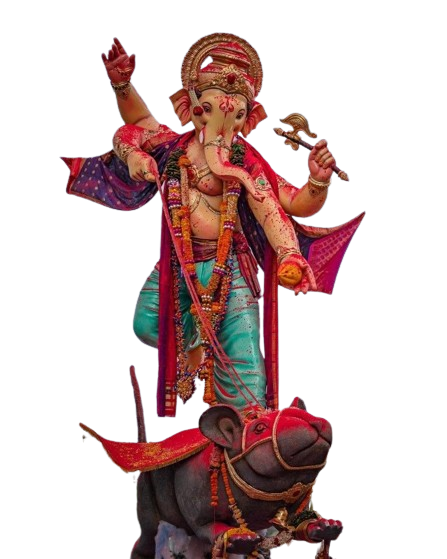Introduction
- Introduce Lord Ganesha, commonly known as Ganpati Bappa, as one of the most revered deities in Hinduism.
- Mention the significance of his vahana (vehicle), the mouse, known as Mushak or Mushika.
- Briefly explain the symbolism of Ganesha and Mushak in Hindu iconography.

| Ganpati Bappa PNG Blackground : |
| PNG Size : 254 KB |
| Png License : Use Personal Work |
| Resolution Size : 447 x 559 |
| Image Type : PNG |
The Iconography of Ganesha
- Appearance: Describe the typical depiction of Ganesha with an elephant head, four arms, and a large belly, symbolizing wisdom, strength, and abundance.
- Attributes: Mention the objects he holds, such as a trident, lotus, modak (sweet), and a broken tusk.
- Significance: Explain how each attribute represents different aspects of life, like intellect, prosperity, and overcoming obstacles.
The Symbolism of Mushak (The Mouse)
- Role in the Iconography: Discuss how the mouse is often seen at Ganesha’s feet or as his vehicle, symbolizing humility and the importance of even the smallest creatures.
- Mythological Stories: Share some popular stories that explain how the mouse became Ganesha’s vehicle. For example, the story of Krauncha, a celestial musician cursed to become a mouse, and his redemption.
- Symbolic Meanings: The mouse represents desires and ego, which Ganesha controls and guides, emphasizing the importance of mastering one’s desires and ego.
Cultural and Religious Significance
- Ganesh Chaturthi: Describe the celebration of Ganesh Chaturthi, where idols of Ganesha are worshipped, and the mouse is acknowledged as his faithful companion.
- Art and Popular Culture: Discuss the portrayal of Ganesha and Mushak in various forms of art, from traditional paintings to modern digital illustrations.
The White Background in Iconography
- Symbolism of Colors: Explain the significance of a white background in images and artwork. White often symbolizes purity, peace, and spiritual transcendence in many cultures.
- Visual Impact: Discuss how a white background can emphasize the figures of Ganesha and Mushak, making them the focal points and highlighting their symbolic meanings.
The Human Touch in Art
- Depicting Human Emotions: Explore how artists capture the human touch and emotions in the depictions of Ganesha and Mushak. This can include expressions of wisdom, compassion, and joy.
- Contemporary Interpretations: Mention how modern artists might incorporate human elements or contemporary symbols to make the depictions more relatable to today’s audience.
Conclusion
- Summarize the significance of Ganesha and Mushak in Hinduism and broader cultural contexts.
- Reflect on the enduring appeal of their imagery and the messages they convey about wisdom, humility, and spiritual growth.
Visuals
- Consider including a high-quality PNG image of Ganesha with Mushak on a white background. Ensure the image respects cultural sensitivities and copyrights.
This outline can be expanded into a detailed article, providing readers with an informative and engaging exploration of Ganpati Bappa and Mushak.
Ganpati Bappa With Mushak PNG Blackground